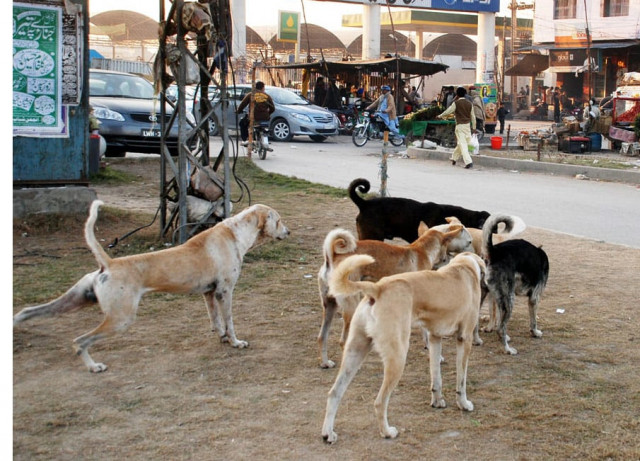Bitten to death: Did anyone hear the howl?
Every year, 5,000 Pakistanis die an avoidable death, a death so painful that loved ones wish victims had died sooner

A common misperception is that you can only get rabies if you are bitten by a dog. No! Cats, mongoose, monkeys, bats and sheep can also carry the virus! PHOTO: EXPRESS/FILE
At a shrine in Ranipur, Sindh, mothers take their sick children, wrapped in a green shawl, and pray to the Almighty for their death. This is a ritual that dates back to the 18th century and is still being practised to rid those who have been infected by the rabies virus of their suffering. So intense is the victims’ suffering that their mothers actually kneel before God, begging Him to take away the life of their child as they cannot bear to see them in their agony as mute witnesses.
“It shows massive failure on part of our government. Rabies is preventable, but in Pakistan, the virus claims close to 5,000 lives every year, and these are just reported cases,” states Dr Naeem Qureshi, a government officer who has dedicated his life to the eradication of the virus from Pakistan.
Answers in a vaccine
The irony: The National Institute of Health (NIH) is still producing the Sheep Brain Vaccine (SBV), which has been rendered obsolete for almost 20 years in developed countries. This method of vaccination involves a brutally painful administration of 14 injections straight into the stomach, once every day continuously for two weeks.
“Often, the patients come to hospitals for 4 to 5 injections, and because they cannot afford the travel and lodging expenses to come to the hospital every day, they discontinue the treatment. Full-blown rabies and then a certain death await them,” states Dr Naseem Salahuddin, senior consultant at the Indus Hospital.
Moreover, if the SBV is defective, the patient runs the risk of contracting the virus through the vaccination itself.
The Cell Culture Vaccine (CCV) is a cost- and time-effective treatment and Dr Salahuddin, along with her team, are working towards educating the health sector towards adopting this method instead of the dated and painful SBV. Instead of 14 injections, this vaccine offers treatment in just five injections and is administered intra-dermally to the arm, and thus a lot less painful. The Indus Hospital in Karachi is a pioneer in teaching other hospitals across Sindh on how to effectively administer this vaccine, and all of this training is done free of charge.
With relentless efforts of committed people like Dr Naseem Salahuddin, the government has agreed to open 10 rabies prevention centres in each province. Thus far, a centre in Hyderabad is up and running and three more in Nawabshah, Mirpurkhas and Badin are set to open by the end of this month. Free vaccinations will be administered to patients suffering from bites from rabid animals here.
Doing God’s work
Dr Qureshi is travelling even on the 9th and 10th Muharram to interior Sindh to train doctors. When asked about the dangers, he casually stated, “I am not afraid to do God’s work.”
God’s work is exactly what this is -- for the horrors of a death by rabies are unsurpassed. Symptoms of the virus include fever, headaches and mental confusion. This is followed by an appalling fear of water and difficulty in swallowing. The death that follows within 5 to 7 days is horrifically painful and absolutely certain.
Rabies in Pakistan is transmitted by dogs in 99% of the cases. However, other animals including cats, mongoose, monkeys, and in some cases even sheep, have been known to carry the virus.
For those bitten by a rabid animal, however, just administration of the vaccination is not enough. Deep wounds require the Rabies Immune Globulin (RIG) which is injected directly into the wound. Without this, even the CCV is not enough to prevent the onset of rabies.
Dr Qureshi describes a lack of knowledge of this crucial drug on behalf of the health sector. “They are not aware as to just how important RIG is, which is why there is not budget for it,” he points out.
Dr Salahuddin is fighting tooth and nail for the availability of RIG round the year, in at least the 10 Rabies Prevention Centres being built in every province, but where money is concerned, the battle is fierce.
Without RIG, Dr Salahuddin says, any amount of other vaccinations is pointless. “I do not want to see another person die an agonising death”.
Raising awareness
The other issue is awareness, as described by Dr Qaid Saeed, National Programme Officer in the WHO, Islamabad.
“I once visited a village where a boy who was suffering from a dog bite was abandoned; locked up in a dark room and completely isolated from everyone. This was the local Pir’s remedy to rid one of rabies.”
Rabies is a neglected disease, one that typically claims the lives of those too poor to know better, but it is through efforts of people working behind the scenes that lives are saved. “Even one death from rabies is one too many; the pain is just too great,” states Dr Qureshi as he sets off to Dadu to train doctors on how to prevent this painful and fatal disease.
Myth 1
Rabies is transferred from human to human. It is not! Only animals can host and transfer rabies virus
Myth 2
Rabies causes people to act like dogs. It does not! People with rabies do not bark and howl
Myth 3
You can only get rabies if you are bitten by a dog. No! Cats, mongoose, monkeys, bats and sheep can also carry the virus!
Published in The Express Tribune, November 15th, 2013.



















COMMENTS
Comments are moderated and generally will be posted if they are on-topic and not abusive.
For more information, please see our Comments FAQ